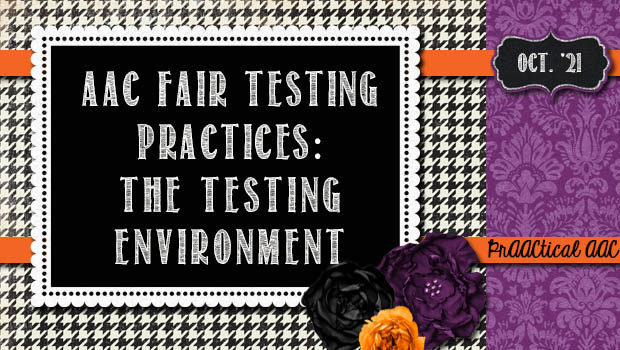AAC Fair Testing Practices: The Testing Environment

Today, we’re continuing our discussion of Fair Testing Practices for people who use AAC and need to participate in assessments. So far, we’ve talked about the rationale for this approach and considered things that we need to address in two areas: Preparation for the assessment and the various options for how to respond when faced with different types of test questions (e.g., multiple-choice, fill-in-the-blank).
In this post, we turn our attention to things that impact the test environment.
Topic 7: Can anyone test this student or are there specific skills and characteristics that the evaluator should possess?
There are many things that influence our performance on tests. For individuals who use AAC, it’s important to consider who will be administering the assessment. Here are some topics that teams can discuss to approach this in a way that will be fair to the AAC user.
- AAC Knowledge and Skills: In most situations, the person being tested is not yet proficient with their AAC device. These individuals will need to be tested by someone who understands their AAC system and uses supportive interaction strategies. For example, the evaluator may need to use strategies such as extended pause (wait) time or Partner Assisted Scanning. They also need to know how to resolve communication breakdowns.
- Recognizing and Responding to Multimodal Communication: People communicate in many ways, and it is important for the evaluator to understand the specific methods and signals used by the person they are testing. The evaluator should be aware of their yes/no signals, how the AAC user asks for help, and ways that they might request a break, for example.
- Test Administration Procedures: It goes without saying that the evaluator should have a good understanding of how to administer the assessment and be familiar with the ways that the team has agreed to modify the procedures and/or materials. A ‘cheat sheet’ with key points and reminders can be very helpful even for experienced evaluators.
- Relationship with the Person Who Uses AAC: For some individuals, particularly those who experience anxiety, we have to ensure that the AAC user is comfortable with the evaluator. If they are not already familiar with one another, it may be best to spend some time developing a working relationship before the scheduled test session.
- Attitude and Beliefs: When people underestimate us or don’t have confidence in our knowledge and skills, it influences how we respond. Teams should take the necessary steps to avoid pairing the AAC user with evaluators whose attitudes or beliefs may undermine the individual.
Topic 8: How long can the student work before the results reflect fatigue or reduced attention more than knowledge and skills?
- The conditions that cause the need for AAC can also make it more likely for the individual to tire or concentrate, both of which can negatively impact test performance. To avoid those situations, teams should discuss these questions.
- Does the individual need to be tested in several shorter sessions rather than completing the assessment in one sitting?
- What length of time is appropriate for testing this individual?
- What signs should the evaluator look for to determine when fatigue and difficulties with concentration are beginning to impede performance?
Like the rest of us, people who use AAC are not static individuals with a fixed set of needs, which means that even the most well-thought-out plan might need further adjustment. For the most part, though, these sorts of conversations will help teams develop a blueprint for testing the AAC user in fair and appropriate ways.
Stay tuned for the next post in this series, which looks specifically at the testing materials and considers what changes might need to be made.
Filed under: Featured Posts, PrAACtical Thinking
This post was written by Carole Zangari
